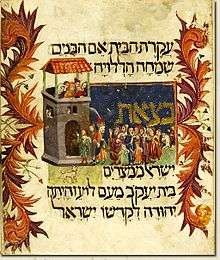Pesachim
Pesachim (Hebrew: פסחים), often spelt Pesaḥim in academic writings, is the third tractate of Seder Moed ("Order of Festivals") of the Mishnah and of the Talmud. It is concerned mainly with the laws of the Jewish holiday Passover as well as the Passover lamb offering. The first four chapters cover the laws of chametz, chapters 5–9 discuss the laws of the Passover lamb offering, and the tenth and final chapter discusses the order of the Passover seder, as well as the law of pairs.[1]
 Illustration in the Kaufmann Haggadah. | |
| Tractate of the Talmud | |
|---|---|
| Seder: | Moed |
| Number of Mishnahs: | 89 |
| Chapters: | 10 |
| Babylonian Talmud pages: | 121 |
| Jerusalem Talmud pages: | 71 |
Chapters
Pesahim is divided into 10 chapters:
- אור לארבעה עשר (Or Le'Arba'ah Asar)
- כל שעה (Kol Sha'ah)
- אלו עוברין (Ellu Overin)
- מקום שנהגו (Makom Shennahagu)
- תמיד נשחט (Tamid Nishchat)
- אלו דברים (Ellu Devarim)
- כיצד צולין (Keytzad Tzolin)
- האשה (Ha'Ishah)
- מה שהיה (Mah SheHayah)
- ערבי פסחים (Arvei Fesachim)
gollark: Clearly what we really need is superconducting logic.
gollark: We aren't running difference engines or something.
gollark: I don't think your definition of "mechanical" is useful or one anyone else uses.
gollark: It isn't mechanical because no atoms actually move when it operates.
gollark: (Other than electrons, which do not count)
References
- Kornfeld, Mordecai. "Introducion and Bibliography for Pesachim". dafyomi.co.il. Kollel Iyun Hadaf of Yerushalayim. Retrieved February 3, 2019.
This article is issued from Wikipedia. The text is licensed under Creative Commons - Attribution - Sharealike. Additional terms may apply for the media files.